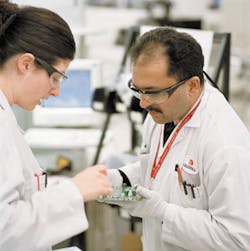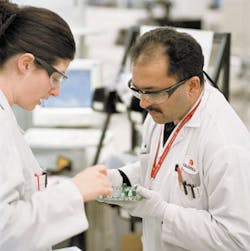RoHS one year later: supplies of leaded solder drying up
By Keith Gurnett and Tom Adams
When the European Union’s RoHS (Restriction of Hazardous Substances) legislation took effect one year ago, it marked the beginning of the end for most electronics assemblies containing leaded solder, and the beginning of a nearly universal franchise for lead-free solders.
The RoHS legislation covers six hazardous materials-lead, mercury, cadmium, hexavalent chromium, polybrominated diphenyl ether, and polybrominated biphenyl-but by far its greatest impact in terms of economics and breadth of applications is in leaded solders.
Although military products in the EU can be exempted from RoHS, and although the U.S. as yet has no similar federal legislation, the impact of the July 1 deadline was profound, largely because military procurement specialists who purchase COTS components are seeing the leaded versions of those components begin to disappear from the marketplace.
In one sense, July 1, 2006, is when the music stopped. Component supplier Avnet had been busy for months helping customers prepare for RoHS, both in the U.S. and in Europe, notes director of strategic planning Steve Schultz. Customers were calling and asking for certification and for clarification of issues.
“But then July 2 came, and my phone stopped ringing a lot,” Schultz explains. Companies that had been rushing their compliance plans were finished with those plans, he suspects; companies that had no compliance plans were still quietly working on them. But Schultz thinks that part of the calm after the storm may also have been caused by the lack of active enforcement of RoHS, especially in the United Kingdom
In the United Kingdom, enforcement of the provisions of RoHS is the business of the National Laboratory of Weights and Measures. After July 1, the National Laboratory was, outwardly, very quiet-there were no announcements of culprit companies being prosecuted for using leaded solders. Instead, the National Laboratory was working with not-quite-compliant firms to resolve problems. The Laboratory maintained a very low public profile, so low that a message on their Web site warned that they would not take phone calls from journalists.
A response eventually received from the Laboratory explained that they are using XFG guns (x-ray fluorescence analyzers) to inspect manufactured products for the presence of lead, and that these inspections “are being used as a route to open dialogues with companies.”
The Laboratory’s intention is to use persuasion rather than prosecution to bring out compliance with the provisions of RoHS: “ . . . if we can satisfy the directive without using the legal tools, we will. We will not use legal tools unless all other avenues are closed.” But the Laboratory also declined to comment on whether they have actually launched any legal actions against companies that may have violated the terms of RoHS.
Vanishing components
One of the more predictable consequences of RoHS began to make itself felt after July 1: some leaded components began to disappear from the supply chain. Marjory Craw-Ivanco, director of engineering services, lab services, and green services at Celestica Inc. in Toronto, sees that even companies that have exemptions from RoHS are beginning to convert their products to lead-free. “I think the realization is out there that you can’t avoid being impacted by RoHS,” she says. “As this trend continues I think we will see more and more of a situation where the non-RoHS compliant components-the non-lead-free components-will become more and more difficult to obtain. And under those circumstances military customers will be in a bit of a pickle, because they won’t be able to obtain leaded components.”
Steve Schultz at Avnet says that some leaded components are still available in the supply chain. “Avnet, for example, is still selling a lot of tin-lead product, which a year or two years ago we guessed that we would have gotten rid of somehow,” he explains. “Now we’re very glad that we have it.”
The decision to continue stocking leaded components, he explains, was not easy, but it turned out to be the right choice. But as these stocks run out, they are not being replaced. “We’re still selling a lot of the tin-lead version of parts to the military, but we can’t get any more. If we could right now, we would go out and buy some leaded product, because we still have plenty of demand in a number of customer segments-military is one of them.”
A few manufacturers, he adds, originally switched from leaded to lead-free components, and then more recently, because of the demands of their military and aerospace customers, abandoned lead-free and returned to making leaded components.
But change occurs at different rates in different environments. At the U.S. Defense Supply Center Columbus (DSCC), where the emphasis is on design and engineering, the impact of RoHS-related change comes somewhat later. “For the mil-spec parts that we document and qualify, we’ve not really run into any situations where the availability of primarily the tin-lead product that we buy [has been a problem],” says Dave Moore, chief of the document standardization unit at DSCC.
“We know in the commercial world there are lots of issues in all this, but we haven’t had a single situation that I’m aware of where a QPL (Qualified Products Lists) or QML (Qualified Manufacturers Lists) supplier of tin-lead products in our program has come back and said you’re not going to be able to get the tin-lead any more. So we’re OK on the mil-spec parts, but we know that the commercial area has some significant challenges.”
One of the inevitable consequences of parts scarcity is higher prices. Moore has not seen higher prices yet, but would not be surprised to see them in the near future. Both Craw-Ivanco and Schultz have noticed this. Craw-Ivanco estimates that prices for still-available leaded components have generally gone up by 5 to 10 percent since July 1.
Lead-free questions
For military and aerospace applications, the looming question is whether lead-free products can achieve the same long-term reliability as leaded products. Tin whiskering is an obvious obstacle to reliability, but there are other significant questions in this area as well: How do you achieve reliability when the two types of solder are mixed on the same board? How does rework of a lead-free board change the system’s long-term reliability?
Interest in finding answers to these questions grew substantially after July 1, and it is probably fair to say that many involved firms and organizations accepted the fact that lead-free components were here to stay and began to tackle the tough questions. One example is the Joint Group For Pollution Prevention (JGPP), which had already carried out a project on lead-free solders. After July 1, says NASA’s Kurt Kessel, JGPP decided to do a second project, focusing this time on rework of lead-free components.
“I have seen very little data on the rework aspect of lead-free,” he says. “How reliable are solder joints after you’ve reworked them? How about the board-is the board going to start warping and delaminating if you have to have all of those high temperatures? Do you have to have all of those high temperatures with rework? There are a lot of unanswered questions.”
Kessel says JGPP hopes to have the test vehicles built during 2007, and to begin testing this year. Results might be available as early as next year-“dependent on the duration of the tests we decide to run, as well as how much rework we incorporate into this. We may wind up with some very long lead times with our assembly process if we have a lot of rework. Who know what unforeseen things may come about when we start doing more and more rework on these test vehicles?”
Dave Moore and his colleagues at DSCC will look closely at the outcomes of the JGPP work. After testing, the group might find, for example, that SAC 305 (Sn96.5/Ag3.0/Cu0.5) provides acceptable reliability in military applications. In that case, Moore and his colleagues would plan to introduce new parts numbers so military customers could use the lead-free solder.
But such a decision will not be taken lightly, Moore explains. “In the parts engineering world . . . we sit down with a cross section of the QPL QML manufacturers that make the parts, the major contractors that design and build them in, like Lockheed and Boeing, and also our major military customers, and civilian agencies, like NASA. It’s a joint effort, and we get involved to make sure we’re stepping forward, because when we do introduce lead-free parts-and if we do introduce them-they will be standard-type products that everyone will use.”
Celestica has joined a consortium called LEAP (Lead-free Electronics in Aerospace Project), according to Marjory Craw-Ivanco. The overall purpose of the group is to determine the long-term reliability of lead-free solders in military and aerospace environments. This means conducting, for example, accelerated thermal-cycling tests that conform to the more rigorous temperature range of military and aerospace environments. “Although all guidance at this point indicates that the reliability of lead-free assemblies looks reasonably good when using the models we have for tin-lead, there is concern that when you get into these harsh environments there could be different failure mechanisms that folks don’t really understand yet,” she explains.
Reballing parts
Technically, one of the major areas of interest since July 1 has been the process of reballing a component by removing the leaded solder balls and replacing them with lead-free balls. A number of laboratories are offering this procedure, whose application is restricted almost entirely to BGAs.
This procedure might work with commercial products, but is it acceptable for military and aerospace applications? Marjory Craw-Ivanco is doubtful that it would be. First, she points out, the warranty on the original component is voided when the solder balls are removed. Another concern: removing and replacing the solder balls involves heating the component. Suppose the same component later needs to be reworked-how much heat can it stand without compromising its reliability?
But out of necessity reballing is being done on military parts. Logan Willis, vice president for technical sales at eTech-WEB Inc. in Austin, TX, estimates that 30 to 35 percent of its BGA reballing is done for military applications. The overall volume of reballing has increased since the July 1 RoHS deadline, and he thinks that volume will continue to increase.
Interestingly, not all of the reballing that his firm does involves removing lead-free solder balls and installing leaded solder balls. A small percentage of the work (none military) goes in the other direction: leaded solder balls are removed and lead-free balls are put on. “There are issues with that,” Willis explains, “because the package may not be rated for that higher temperature.” Customers run extensive tests on the reballed parts to ensure their reliability.
Where To From Here?
Among the likely events in 2007 will be the first publicized prosecutions of noncompliant firms in the United Kingdom. After years of uncertain standards and shifting exemptions, prosecutions will at least provide a solid framework by which other western firms can operate.
Lurking in the shadows is China RoHS, which promises to take a different tack, along with the prospect of federal RoHS legislation in the U.S., which may be enacted-if for no other reason-to prevent each of the 50 states from writing their own laws. One day, perhaps, we may even all speak the same RoHS language.

